Robert Haugen, Ph.D., Flow Sciences
Abstract:
The most obvious barrier between a lab worker and a potential experimental accident is the fume hood sash. Ideally, we want such a sash to protect the researcher from eruptions, spatters, and other dangers present in typical reactive chemistry.
Like many other issues involving materials of construction, fume hood glazing comes in a variety of designs and specifications.
The writer will set forth the glass types available for fume hood construction and discuss standards typically used to help specify this glass in a useful manner. It will also be noted that some safety glass types now specified are neither preferred nor reliably defined.
These issues of vagueness lead to confusion among lab planners and specifiers attempting to describe fume hood glass that is appropriate for a given application.

Sash Glass Options Often Specified for Chemical Fume Hoods:
- Annealed glass: While annealed glass is never used in fume hoods 23, its manufacturing process gives us a clue about various strengthening procedures we will later describe in detail.
“Annealed glass is glass produced without internal stresses imparted by heat treatment, i.e., rapid cooling, or by toughening or heat strengthening. Glass becomes annealed if it is heated above a transition point then allowed to cool slowly, without being quenched. Glass is treated with heat in order to change its properties by the annealing process. Annealed glass is the most common glass used in windows. Annealed glass is also known as a standard sheet of float glass.”22
“Glass which has not been annealed is liable to crack or shatter when subjected to a relatively small temperature change or mechanical shock. Annealing glass is critical to its durability. If glass is not annealed, it will retain many of the thermal stresses caused by quenching and significantly decrease the overall strength of the glass.”22
So annealed glass, because of its method of manufacturing, is free of irregular internal stresses which can make glass fragile and more brittle. The product we start with in any strengthening procedure is therefore stress-free and capable “as is” of reliable use for many construction purposes.
1) Laminated Glass:
This form of safety glass is designed to hold together when shattered2. Laminated glass is typically constructed from annealed glass lites with a layer of some kind of plastic in the middle (interlayer). The interlayer is typically PVB (Polyvinyl butyral) or EVA (ethylene-vinyl acetate). Both interlayer types form a bonded interface with the glass, making a sandwich that is very difficult to penetrate or shatter. Either interlayer material type tends to hold the glass together when the panel becomes damaged through impact.
Most specifications sent to Flow Sciences for quotation call out a PVB interlayer and a total glass –interlayer-glass thickness of not less than 7/32”. Flow Sciences uses nominal ¼” glass as our standard.

2) Tempered Glass:

As a result of its safety and strength, tempered glass is used in a variety of demanding applications, including passenger vehicle windows, shower doors, architectural glass doors and tables, refrigerator trays, mobile screen protectors, as a component of bulletproof glass, diving masks, and various types of plates and cookware. 4
In chemical fume hood applications, extreme heat would require tempered glass which does not fracture due to heat until about 450o F. Laminated safety glass may crack at or above 160o F. When tempered glass does break, the entire sheet winds up in tiny glass shards due to the uniform stressed structure that increases its resistance to impact.
At least one major fume hood manufacturer6 is currently using ¼” tempered glass fume hood sashes. Flow Sciences and most other North American manufacturers use laminated safety glass.
3) Laminated-tempered Glass:
“Laminated/Tempered glass is a hybrid of two strong types of glass: Laminated glass, which consists of two glass panes with a thin, clear vinyl layer in between that prevents the glass from shattering on impact, and tempered glass, which has been heat-treated to make it harder and more durable than standard glass.”9
This type of glass appears occasionally in fume hood specifications. It creates several problems for companies seeking to provide fume hoods with this glass:
- Fume hood design requires glass parts of non-standard dimensions (sash, bypass panels, light lens, etc.). All glass lites to be used to make a piece of lami-temp must be first pre-cut into two sets of pieces from non-tempered glass. These lites are then tempered in an oven to create thin (~2 mm) tempered glass panels. Each matching pair of panels must then be laminated together using a PVB interlayer. Typically, this safety glass must have a total thickness of no more than ¼”. Unfortunately, one cannot start with a big sheet of lami-temp glass and cut it, because the cutting motion will cause the piece to shatter at the instant the surface is scratched. Therefore, one must start with pre-cut lites of annealed glass, temper them, and then laminate matching tempered pieces together.
- The method described above of manufacturing each piece of laminated-tempered glass is time and labor consuming. Lites this thin are difficult to temper and then laminate due to breakage and other issues. There is no alternate way to make custom cut pieces with any better efficiency. Most fume hood manufacturers find the cost and manufacturing risk of this product prohibitive for standard product, and only offer this option if specified by the customer.
4) Other types of glass occasionally used in fume hoods.
Infrequently, other types of fume hood sash glass have been specified:
- “Bullet proof” glass is usually a combination of polycarbonate (Lexan) and glass in layers. The illustration below shows a cross section of this product comprised of two glass layers and three layers of polycarbonate film.11
This material is usually sold in thicknesses greater than ¼” The department of defense has specified this product be used in some marine fume hood applications. Again, the constituent glass parts must be made separately and then joined together for each piece as the product cannot be cut once fabricated.
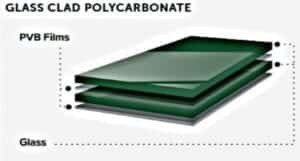
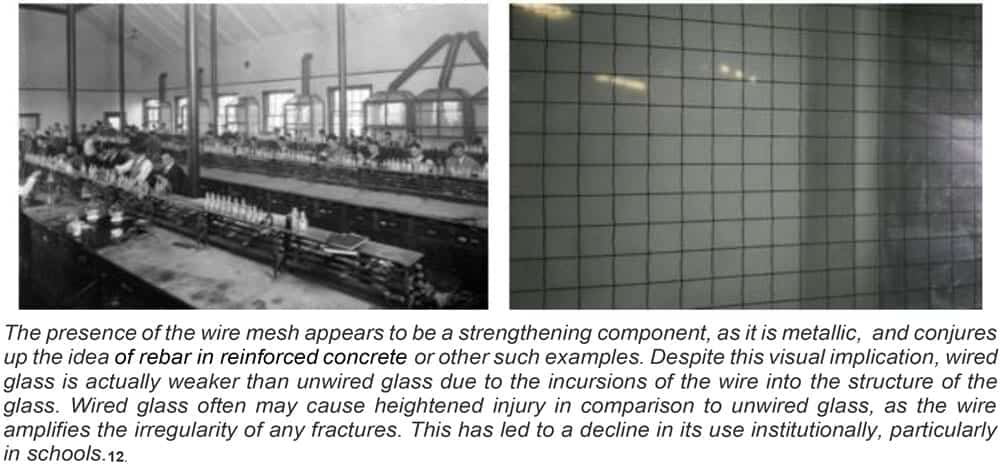
The presence of the wire mesh appears to be a strengthening component, as it is metallic, and conjures up the idea of rebar in reinforced concrete or other such examples. Despite this visual implication, wired glass is actually weaker than unwired glass due to the incursions of the wire into the structure of the glass. Wired glass often may cause heightened injury in comparison to unwired glass, as the wire amplifies the irregularity of any fractures. This has led to a decline in its use institutionally, particularly in schools.12
The Influence of Various Standards on Fume Hood Glazing:
1) ANSI / AIHA Z 9.513 is the over-arching standard for fume hoods and other lab containment equipment. It calls out other standards within its arc of proper lab outfitting including fume hood containment testing and materials, including glass. ANSI AIHA Z9.5 states that fume hood sash glass should be shatterproof (no standard referenced).
No other codification, identification or mention of sash glass material or other glazing practices in fume hoods is mentioned in this entire standard. Not much help here!

2) SEFA 1 14 is a different standard written by members of the Scientific Equipment and Furniture Association.
Section 4.1.8, 2016 States: “Most lights are fluorescent tubes housed outside the hood chamber and separated by a vapor resistant safety glass panel in the top of the hood. The standard does not specify what type of safety glass should be used and what standard should be applied. Not much help here either!”
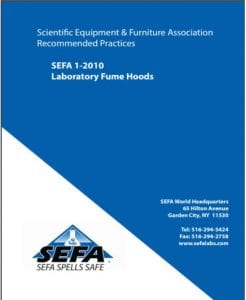
3) ANSI Z97.1 – 2015 15 delineates the most comprehensive list of definitions and standards for various forms of safety glazing:
a) Laminated
b) Tempered
c) Organic coated
d) Plastic

It must be emphasized, however, that no definition of laminated-tempered glass is offered herein.18
ANSI AIHA Z97.1 offers separate methods for testing laminated and tempered glass, but says nothing about testing or certifying laminated-tempered glass, even though there are major differences in the cracking, initiating energy, and thermal behavior of these materials.
This section is reproduced below to show how the standard does not specifically address laminated-tempered safety glass:
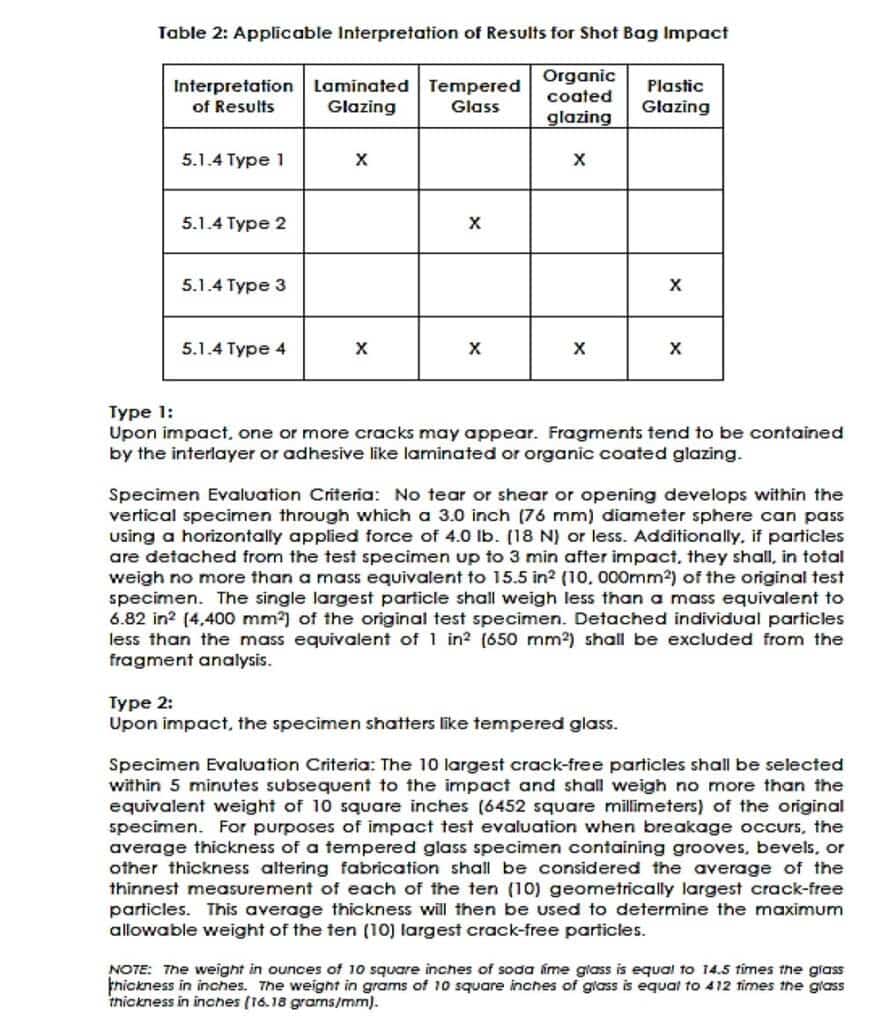
Note: Even though the above text of Z97.1 reviews SEPARATE methods for “shot bag” testing laminated and tempered safety glass, by industry convention, any laminated glass made up of any kind of glass lites is regarded as laminated glass and is tested using column two criteria of the ANSI Z97.1 – 2015 standard. Flow Sciences obtained samples of lami-temp glass 8mm thick for testing and evaluation. Each sheet came with the permanent label shown in the photo below:

There is inherent confusion in this label. Note the “HS” in the expression TEMPERED/H.S. It turns out that tempered glass comes in several categories, including HS (heat-strengthened) and FT (fully tempered). Here is a definition from the literature of HS and FT grades:
“The most dramatic and important difference between heat strengthened and tempered glass is in the post breakage characteristics of the two products (i.e. break pattern). If heat strengthened glass (HS) should break, the pieces will be relatively large and tend to remain in the glazing system until removed. Tempered glass, on the other hand, is designed to break into innumerable small, roughly cubical pieces. In fact, it is this break pattern that qualifies tempered glass as a safety glazing material. However, because of the break pattern, tempered glass is much more likely to evacuate the glazing system immediately upon breakage. Responsible design professionals must consider the tendency of tempered glass to evacuate the opening upon breakage and the consequences must be acceptable. Responsible parties know that there is always a possibility of glass breakage. The glass construction must be designed with a low probability of breakage, typically less than 8 panels per 1000 panels, but if the glass does break, the glass design must be done in a manner so that the breakage consequences are acceptable.” 20
A more direct explanation is offered by Vitro Architectural glass22:
“There are two different types of heat-treated glasses, heat-strengthened and tempered. The similarities between the two include:
- Production using the same processing equipment
- Heating the glass to approximately 1,200 degrees Fahrenheit, then force-cooling it to create surface and edge compression
The differences between the two glasses are as follows:
- With tempered glass, the cooling process is accelerated to create higher surface compression (the dimension of force or energy per unit area) and/or edge compression in the glass. It is the air-quench temperature, volume and other variables that create a surface compression of at least 10,000 pounds per square inch (psi). This is the process that makes the glass four to five times stronger and safer than annealed or untreated glass. As a result, tempered glass is less likely to experience a thermal break.
- With heat-strengthened glass, the cooling process is slower, which means the compression strength is lower. In the end, heat-strengthened glass is approximately twice as strong as annealed, or untreated, glass.”
Heat-strengthened (HS) laminated-tempered glass shatters into relatively large pieces when cracked, held together by the plastic interlayer.

This breakage pattern is actually better in some applications than an FT laminated panel, which would totally fracture into tiny cubes held together by the interlayer. Such broken panels of FT lami-temp could drop or sail into a work area like a “wet blanket.” See photo below:

4) ASTM C1048-18 also describes various types of tempered and laminated glass.

The C1048-18 abstract states the following:
“This specification covers heat-treated flat glass – kind HS, kind FT coated and uncoated glass used in general building construction. Glass furnished under this specification shall be of the following conditions: condition A – uncoated surfaces, condition B – spandrel glass, one surface ceramic coated, and condition C – other coated glass. Flat glass furnished under this specification shall be of the following kinds: kind HS – heat-strengthened glass shall be flat glass, either transparent or patterned, in accordance with the applicable requirements, and kind FT – fully tempered glass shall be flat glass, either transparent or patterned in accordance with the applicable requirements. All fabrication, such as cutting to overall dimensions, edgework, drilled holes, notching, grinding, sandblasting, and etching, shall be performed before strengthening or tempering and shall be as specified….”
Note the last sentence above: once glass is tempered, it may not be cut. This material cannot be dimensionally field modified. Incidentally, nowhere in this standard is laminated-tempered glass mentioned.
5) 16 CFR 1201: This is part of the larger standard Code of Federal Regulations Title 16: Commercial Practices. Part 1201 is the Safety Standard for Architectural Glazing Materials. It contains the principal set of rules and regulations issued by federal agencies regarding commercial practices for glass.

Discussion: Where Are We left?
On the positive side, American manufacturers are given clear ways to label and classify laminated, tempered, or laminated-tempered safety glass. The operative standard here would be ANSI Z97.1. Additional information on classifying tempered safety glass is provided in ASTM C1048.
Below is the label marked on every sheet of standard laminated safety glass Flow Sciences receives, cuts, and then uses in the Saf T Flow fume hoods manufactured here in the United States. Among other standards, note ANSI Z97.1 is prominently referenced. Tempered, laminated, and lami temp glass are certifiable under the same standard using different pass-fail criteria.
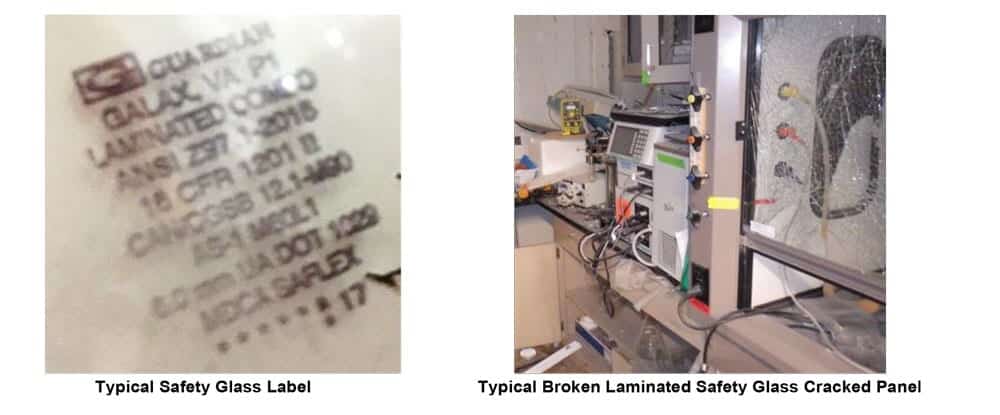
On the negative side, customers occasionally want a different glass product than laminated or tempered. As contradictory as it sounds, the common practice is to test lami temp using the laminated test criterion, not the tempered criterion.
The tests and descriptions for lami-temp glass neglect to specify whether the “tempered” glass used is FT or HS. Several construction specifications call out laminated-tempered glass and say nothing about this issue. The following two examples demonstrate how these vaguely defined and poorly established distinctions can cause serious problems with fume hood glass specifications:
1) A major University requested laminated-tempered glass. It requires 91% transmission or better, Category II compliance under 16 CFR 1201, and a permanent marking from SGCC delineating compliance with listed standard. The specification says nothing about the degree the lites must be tempered.
There is another problem with the same specification: The specified requirement for testing using 16 CFR 1201 Category II criteria states Category II glass “must be used in one of the following building components: shower doors, bathtub doors, sliding glass doors (patio type), storm doors or combination doors that contain any piece of glazing material greater than 9 square feet in surface area, doors that contain any piece of glazing material greater than 9 square feet.” CFR 1201 is therefore not applicable using this specification because none of the included Category II materials are fume hood sashes.
As stated earlier, the CFR 1201 Category II dimensional requirements come from the construction industry, where larger thin pieces of FT laminated-tempered glass, when stressed, turn into a one-piece “wet blanket” and may fall out of their frame on a building exterior and become a massive and dangerous falling object.17 The writer therefore believes the large-piece dimensional size requirements are designed to encourage thicker glass panels that will not fall out of their frames when they become shattered. Even though fume hoods are not one of the limited list of products specified in this standard, it is easy to see why CFR 1201 limits the use of laminated-tempered safety glass even in building and construction applications.
Flow Sciences has not wished to use lami-temp glass ¼” thick for fume hood sashes because either (or both) glass lites comprising a panel could easily crack and precipitate a collapse of the entire panel into a single mass of shards which will then potentially fall out of the sash frame in one piece.
2) A second specification for fume hood sash glass was found to call out lami-temp that would comply with ANSIZ97.1, grade B impact performance.
Grade B impact performance is clearly defined in the standard and easy to evaluate whether the two panels used in the structure are glass or tempered glass. As with most fume hood manufacturers, Flow Sciences has its laminated ¼” sash glass fully certified using ANSI Z97.1 to this procedure and will gain no improved impact performance going to lami-temp panels.
In summary, Flow Sciences has found limited advantage in the lami-temp product for many of the reasons cited above. If laminated-tempered glass must be used it should be grade HS since damaged panels have larger pieces less likely to fall out of the framing system. The remaining issue is fully tempered and heat strengthened are poorly differentiated in the standards.
FSI has found laminated glass serves most lab needs better than tempered or lami-tempered products. Laminated glass also has a well-established and regularly-applied standard which makes it useful for upholding our ISO 9001:15 consistency and standard compliance. Under present guidance from relevant standards, HS Lami-temp may not!
Conclusions:
1) The researcher found three types of glass most commonly used in fume hoods: Laminated, tempered, and laminated-tempered.
2) Two types of glass, bullet proof and wired glass, are of minor importance in today’s fume hood market.
3) Fume hoods customarily use laminated or tempered safety glass. Both are typically furnished in either 7/32” or ¼” thicknesses depending on the manufacturer. Both may be tested for compliance using separate criteria in ANSI Z97.1.
4) In distant third place, is the sometimes-specified laminated-tempered safety glass. While such glass has improved performance at high temperature and better impact resistance than laminated glass, it is very complicated to quickly supply or replace and impossible to certify using a standard relevant to fume hood applications. There is an understandably larger cost for the lami-temp manufacturing process which involves factory cutting and piecing together the tempered pieces into the final laminated product.
5) One final point needs to be made regarding fume hood glass standards. The origin of a standard is important when deciding how to apply it to a component of a manufactured product. Department of transportation standards should test products that transport things. The construction industry should use standards related to building products. The fume hood industry, through appropriate groups, should promote or develop glass standards relevant to glass component safety in fume hoods.
As a fume hood manufacturer, FSI must seriously consider glass standards specifically related to fume hoods and their unique safety challenges. This final consummate issue will be developed in a future white paper!
1. “Fume Hood Incident”, MIT 7/2017, https://ehs.mit.edu/site/fume-hood-incident-july-2017
MIT Environment, Health & Safety Office; 265Massachusetts Ave, N52-496Cambridge, MA 02139
2. “Laminated Glass”; https://en.wikipedia.org/wiki/Laminated_glass; 1/21/2019
3. Maryland Glass Doors and Window Repair; http://mdglassdoorsandwindowrepair.com/laminated-glass
4. “Tempered Glass”; https://en.wikipedia.org/wiki/Tempered_glass; 12/5/2018; italicized portion in the text is a direct quotation from this citation.
5. 55 Glass Supply; https://www.55glass.com/temperedglasslosangeles.php;
6. CampbellRhea Lab Shield Fume Hoods; https://www.iciscientific.com/category/labshield;
7. ANSI Z97.1-2015; American National Standard for Safety Glazing Materials Used in Buildings -Safety Performance Specifications and Methods of Test
8. http://www.build.com.au/laminated-glass
9. https://www.onedayglass.com,
10. https://www.youtube.com/watch?v=KvFoNG7pXdk
11. http://security.tssbulletproof.com/bullet-resistant-glass-vs-window-security-film
12. https://en.wikipedia.org/wiki/Safety_glass
13. ANSI/AIHA Z9.5 – 2012, NO REFERENCE REGARDING SAFETY GLASS IN ENTIRE STANDARD.
14. SEFA 1- 2017, p57 section 4.8.1
15. ANSI Z97.1 – 2015, Sections 4 and 5
16. Partial direct quotation from ABSTRACT of ASTM C1048-18
17. https://www.glassonweb.com/article/post-breakage-strength-testing-overhead-laminated-glass-applications
18. ANSI Z97.1-2015, Section C
19. https://ehs.berkeley.edu/lesson-learned-dry-scraping-causes-chemical-explosion
20. http://ravensbyglass.co.uk/wp-content/uploads/2015/04/Ravensby-Glass-Technical-Document.pdf, Ravensby Glass, UK
21. http://glassed.vitroglazings.com/topics/heat-strengthened-vs-tempered-glass
22. http://www.glazette.com/Glass-Knowledge-Bank-79/Annealed-Glass.html
23. Kewaunee, Jamestown, Hamilton, Mott, Flow Science, Labconco specifications all refer to either Laminated or Tempered safety glass for fume hood sashes.
Dr. Robert Haugen
Director of Product and Technology Development
Robert K Haugen currently designs chemical laboratory containment equipment and develops new relevant technologies for Flow Sciences Inc.in Leland, North Carolina. He has also held positions at Kewaunee Scientific, Jamestown Metal Products, and St. Charles Manufacturing in similar capacities for 31 years. Previously, he did analytical chemical work at the University of Illinois (DNA, wastewater, and crop research) and Lawrence Livermore Labs in California (nuclear weapons research).
Dr. Haugen began his career as a curriculum writer for the Illinois Office of Education, developing texts on energy, urban management, and industrial pollution topics.
He received all his degrees from the University of Illinois in Urbana-Champaign, and is currently a member of the American Society of Heating, Refrigeration, and Air Conditioning Engineers, the American Chemical Society, and the National Fire Protection Association. He has participated in the development of both ASHRAE 110-1995 and the current 2016 update.


